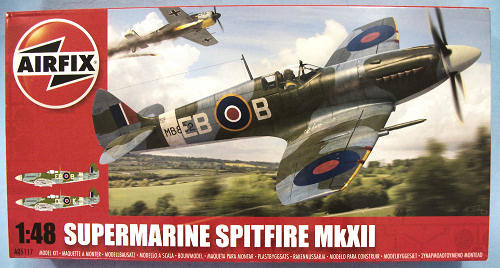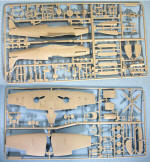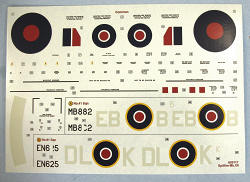Airfix 1/48 Spitfire XII
|
KIT #: |
5117 |
|
PRICE: |
1,920 Yen
(US$23.00) at HobbyLink
Japan |
|
DECALS: |
Two options |
|
REVIEWER: |
Tom Cleaver |
|
NOTES: |
New tool kit |

Developed specifically to combat the low-level
cross-Channel “tip and run” raids by Fw-190 fighter bombers against the
southeast coast of England, the Spitfire XII was the first Griffon-powered
version to see combat.
100 were produced in 1942-43 and served with 41 and 91
Squadrons.
With a single-stage, two-speed blower, the Griffon was maximized
for low altitude performance.
The Spitfire XII saw combat from early 1943 until
September 1944, when 41 Squadron turned in their well-worn survivors for
Spitfire XIVs. In addition to intercepting low-level fighter-bombers, the
Spitfire XII was also used for “anti-diver” patrols in the summer of 1944
against the V-1 “buzz bomb.”
 Over the years, there have been several conversion sets
made to allow a modeler to put a Spitfire XII in the collection.
This being one of my favorite marks of Spitfire, I have
done them all: the hack-and-glue conversion using a Hobbycraft Seafire XV and
the Classic Airframes set with replacement nose and outer wings in resin - both
used with the
Over the years, there have been several conversion sets
made to allow a modeler to put a Spitfire XII in the collection.
This being one of my favorite marks of Spitfire, I have
done them all: the hack-and-glue conversion using a Hobbycraft Seafire XV and
the Classic Airframes set with replacement nose and outer wings in resin - both
used with the
Tamiya Spitfire Vb -
and the Aeroclub full-fuselage conversion for use with the Hasegawa Spitfire IX
kit.
When I participated in developing the Victory Productions decal sheet
“Spitfire: Aces of the Empire,” we made sure to include two Spitfire XIIs.
I am even now preparing to do the 1/32 conversion with
the Greymatter nose and wings, and a Hasegawa Spitfire Vb kit.
While there have been several announcements over the
past few years of a coming injection-molded Spitfire XII from differing
companies, this new kit is the first time any manufacturer has actually made
good on the threat.
After going on the ropes in the past few years and
nearly being given up for dead, Airfix has returned over the past year since
their acquisition by Hornsby, with some interesting new releases of varying
quality levels.
While this new Spitfire is not up to the sublime
heights achieved by the Spitfire 22/24 and Seafire 46/47 kits from 1995, it is
head and shoulders above every other 1/48 Spitfire kit Airfix has ever released
otherwise.
The kit comes on two sprues of light grey plastic, with
a nicely-detailed cockpit - not as detailed as that found in the Hasegawa
Spitfire IX, it is certainly the next-best to that, and more than adequate in
this scale.
One needs only to get a set of 1/48 photoetch seatbelts to “seal
the deal.”
Unfortunately, the kit does not include an instrument panel
decal, its one failing; fortunately, I have an Eduard photoetch panel, which
will be put to use here.
Both tailwheel alternatives - fixed and retractable -
are catered for here. All control surfaces are separate, allowing them to be
posed dynamically, while the elevators are connected to insure proper alignment.
Fabric detail on the rudder and elevators looks very
appropriate.
Do be aware that while the flaps can be posed down, any Spitfire
pilot who did not immediately retract the flaps on touchdown was liable to a
50-Pound fine (not insubstantial when the monthly pay of a Pilot Officer was 70
Pounds).
For some reason, the elusive shapes of Griffon prop
spinners have frequently eluded manufacturers, but Airfix got this one right, as
they also did with the even more elusive shape of the Spitfire XII prop blades.
 The clear canopy parts are very clear and quite thin.
Airfix has done something clever for the open canopy
alternative, molding the rear cockpit glass integrally with the canopy, so it
can be seen, while not resulting in the canopy sitting too high as is frequently
the case with injection-molded parts.
The clear canopy parts are very clear and quite thin.
Airfix has done something clever for the open canopy
alternative, molding the rear cockpit glass integrally with the canopy, so it
can be seen, while not resulting in the canopy sitting too high as is frequently
the case with injection-molded parts.
While the engraved panel surface detail is less petite
than on the Spitfire 22/24 and Seafire 46/47, it is not so bad as was the case
with the Godawful Seafire
III
kit, and looks like all will be well under the proverbial “coat of paint” from
what I have seen so far of built-up models from this kit.
The decals provide markings for the Spitfire XII flown
by Squadron Leader Ray Harries of 91 Squadron, the top-scoring pilot on the
type, which has the early fixed tail wheel, and the much-photographed EB-B of 41
Squadron, which uses the later retractable tailwheel.
I do believe one can say “Airfix is back!”
As someone who built his first Airfix Spitfire
waaaaaaaay back in 1958, this is good news.
It may not compare totally with the Spitfire 22/24 and
Seafire 47, but it certainly can go toe-to-toe with the F.1 Lightning series,
the last good Airfix kits.
Highly recommended.
Tom Cleaver
February 2011
Review Kit courtesy
of HobbyLink Japan.
Get yours at the link
If you would like your product reviewed fairly and quickly, please
contact
me or see other details in the
Note to
Contributors.
Back to the Main Page
Back to the Previews Index Page


 Over the years, there have been several conversion sets
made to allow a modeler to put a Spitfire XII in the collection.
This being one of my favorite marks of Spitfire, I have
done them all: the hack-and-glue conversion using a Hobbycraft Seafire XV and
the Classic Airframes set with replacement nose and outer wings in resin - both
used with the
Over the years, there have been several conversion sets
made to allow a modeler to put a Spitfire XII in the collection.
This being one of my favorite marks of Spitfire, I have
done them all: the hack-and-glue conversion using a Hobbycraft Seafire XV and
the Classic Airframes set with replacement nose and outer wings in resin - both
used with the 